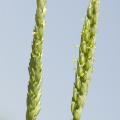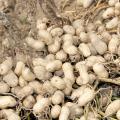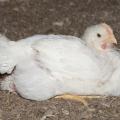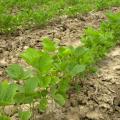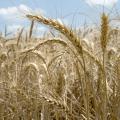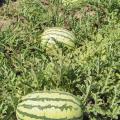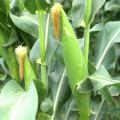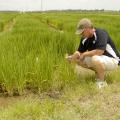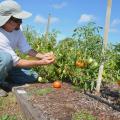Crop Report from 2013
MISSISSIPPI STATE – Cool temperatures through March kept some Mississippians comfortable, but they slowed the development of wheat, the state’s only row crop grown through winter.
Erick Larson, corn and wheat state specialist with the Mississippi State University Extension Service, said wheat acreage is high this year, with 420,000 acres planted in the fall. State growers planted 500,000 acres in 2007, but this year marks the second highest planting since 1990.
MISSISSIPPI STATE – Corn is the anticipated biggest winner and cotton the biggest loser as Mississippi producers shuffle commodity acres to take advantage of market conditions.
MISSISSIPPI STATE – A significant decline in price potential has last year’s peanut growers looking to other crops in 2013.
According to the recent U.S. Department of Agriculture Prospective Plantings report, acreage is declining in every peanut-producing state except Oklahoma. Mississippi is expected to post the greatest percentage decline, down 58 percent from the previous year. The state’s peanut acreage is predicted to drop from 52,000 last year to 22,000 acres this season.
MISSISSIPPI STATE – Mississippi’s strawberry producers may be few in number, but they deliver one of the state’s sweetest and most popular crops.
Growing strawberries in the South is especially challenging because of its variable weather, like that seen this spring.
Wayne Porter, Mississippi State University Extension horticulture specialist in Lauderdale County, said the strawberries struggled because of excessive rain.
MISSISSIPPI STATE – The impact of last year’s drought on feed costs is not the only challenge poultry growers face in 2013.
Production costs, expansion issues, waste regulations, competition from other meat sources and the next grain crop are major factors impacting the poultry industry this year.
“Some of the corn produced last year had to go to ethanol, so supplies are even tighter and have driven up feed costs,” said Tom Tabler, poultry specialist with the Mississippi State University Extension Service.
MISSISSIPPI STATE – Farmers should be nearly finished planting corn and going strong with soybeans, rice and cotton, but instead Mississippi fields are quiet as rain keeps tractors in the barn.
As of late April, the state had gone more than five weeks with only an occasional day or two suitable for planting.
Mississippi corn is in the best shape, at least in terms of the number of planted acres. According to the April 22 U.S. Department of Agriculture Crop Progress and Condition Report, corn is 73 percent planted. Historically, it should be 91 percent complete.
MISSISSIPPI STATE -- As pastures transition from cool-season to warm-season grasses, the state’s hay and forage producers hope for sunny days that are better suited to growing and harvesting quality crops.
MISSISSIPPI STATE – Mississippi’s catfish farmers continue to address production challenges as the industry works to reclaim markets lost to imported fish.
Jeremy Robbins, vice president of The Catfish Institute based in Jackson, said farmers have struggled in recent years with high feed prices, their No. 1 expense, while dealing with increased competition from imports.
MISSISSIPPI STATE -- Poor weather has created so many rain delays that most of the nation’s row crop planting is behind schedule, and Mississippi is even farther behind than other states.
“We’re a month behind,” said Ernie Flint, an area agronomist who has been with the Mississippi State University Extension Service for 22 years. “I’ve never seen anything that compares with this spring. I’ve seen the Delta planted late but never the whole state.”
Before he came to MSU in 1991, Flint spent 18 years as a crop consultant, so he spoke from a long perspective in agriculture.
MISSISSIPPI STATE – Evidence of a healthy national economy may be found in the strength of the timber industry.
Forestry is a billion-dollar industry in Mississippi and the state’s second-largest agricultural commodity. A depressed national economy in recent years had negative impacts on housing construction and furniture manufacturing, which hurt the forestry sector, but industry experts are seeing signs that a recovery is at hand.
MISSISSIPPI STATE – Many Mississippi farmers celebrated Memorial Day in their tractor seats as they took full advantage of about a week of good weather to make significant strides in planting.
A nearly unbroken string of rains kept farmers mostly out of the fields through the early-spring planting window. The U.S. Department of Agriculture’s May 26 Crop Progress and Condition Report shows their efforts to catch up.
MISSISSIPPI STATE – A week of mostly ideal weather allowed Mississippi producers to more than double the acreage planted in cotton, but they remain behind schedule with this year’s crop.
The U.S. Department of Agriculture estimated the cotton crop went from 36 to 77 percent planted in the week ending June 2, and many days were favorable since then. The state typically has 93 percent of its cotton acreage planted by this time, but the situation is not quite as bleak as it had been.
MISSISSIPPI STATE – Late-spring cold snaps and untimely freezes have delayed harvests and reduced yields for Mississippi’s 2013 blueberry crop.
George Traicoff of Hernando runs a family owned and operated you-pick operation in DeSoto County. He started Nesbit Blueberry Plantation with 6,000 plants in 1984, and today his family tends 16,000 plants.
MISSISSIPPI STATE – Producers are bringing in Mississippi’s amber waves of grain later than usual, but sunny weather has allowed them to make strong progress on the winter wheat harvest during the last two weeks.
Wet conditions that began in February and cooler-than-normal conditions in March, April and most of May delayed the crop’s maturity.
MISSISSIPPI STATE – Mississippians love Fourth of July watermelons, and the 2013 melon crop should be worth the wait after weather delays.
David Nagel, horticulturist with the Mississippi State University Extension Service, said the biggest challenge has been the slow growth rate that caused some concern that the first melons might miss the holiday celebrations. The good news is that clear, sunny days with plenty of rain along the way have combined to produce large, tasty melons.
BILOXI – More than 250 boats launched on June 11 to open the shrimp season in Mississippi’s coastal waters.
A cold, wet spring delayed the season’s start, which opened June 1 last year.
“The things farmers hate -- drought and heat -- are great for shrimp production,” said Dave Burrage, commercial and recreational fisheries specialist with the Mississippi State University Extension Service. “The brown shrimp don’t grow as fast under the conditions we had this spring, but once it gets hot, they can go up a whole count size in a week.”
MISSISSIPPI STATE – If Mississippi’s corn growers thought planting season was a wild ride, they better fasten their seatbelts for harvest time.
Erick Larson, corn specialist with the Mississippi State University Extension Service, said wet fields and cooler temperatures last spring resulted in less-than-desirable corn stands, and these conditions often delayed or prevented growers from planting their intended corn acreage.
STONEVILLE – Like most Mississippi row-crops struggling to overcome last spring’s challenges, rice will be at the mercy of late-season weather to produce average yields.
Tim Walker, rice specialist with the Mississippi State University Extension Service, said rains kept farmers from timely plantings. After that, cool spring temperatures slowed growth, putting much of the rice crop about three weeks behind schedule.
Once the crop was established, a new problem emerged.
“The biggest challenge has been herbicide drift from other crops,” he said.
MISSISSIPPI STATE – Greater consumer demand for locally grown produce has made truck crops a bigger part of the state’s overall agricultural production and increased related research at Mississippi State University.
Truck crops get their name from the fact that they are often sold from the back of pickup trucks. They are produce crops, including blueberries, strawberries, sweet corn, beans, tomatoes, watermelon, greens and squash.
MISSISSIPPI STATE -- The spring’s planting challenges and last year’s Midwest drought boosted soybean prices for a while, but the winds of change are starting to blow.
Brian Williams, agricultural economist with the Mississippi State University Extension Service, said the soybean market had been strong until mid-July. The market typically drops before harvest, but he said prices dropped a bit faster this year.

